Abstract
As quantum computers grow in complexity, the technology will have to evolve from large distributed systems to compact integrated solutions. Spin qubits in silicon quantum dots are thought to offer good scalability because both spin-carrying quantum dots and support complementary metal–oxide–semiconductor (CMOS) electronics can, in principle, be monolithically integrated on a single chip. However, monolithically integrated quantum–classical hybrid circuits based on industry-standard CMOS technology remain limited. Here we report a millikelvin integrated circuit fabricated using 40 nm CMOS technology that integrates silicon quantum-dot arrays with support electronics in an architecture that allows the array to be efficiently addressed and read. The architecture contains integrated microwave lumped-element resonators for dispersive sensing of the charge state of the quantum dots, mediated via digital transistors in a column–row-addressing distribution. With the chip, we demonstrate combined time- and frequency-division multiplexing, which scales sublinearly the resources as well as footprint required for readout.
This is a preview of subscription content, access via your institution
Access options
Access Nature and 54 other Nature Portfolio journals
Get Nature+, our best-value online-access subscription
$29.99 / 30 days
cancel any time
Subscribe to this journal
Receive 12 digital issues and online access to articles
$119.00 per year
only $9.92 per issue
Buy this article
- Purchase on Springer Link
- Instant access to full article PDF
Prices may be subject to local taxes which are calculated during checkout




Similar content being viewed by others
Data availability
The data that support the plots within this paper and other findings of this study are available from the corresponding authors upon reasonable request.
References
Montanaro, A. Quantum algorithms: an overview. npj Quantum Inf. 2, 15023 (2016).
Arute, F. et al. Quantum supremacy using a programmable superconducting processor. Nature 574, 505–510 (2019).
Watson, T. F. et al. A programmable two-qubit quantum processor in silicon. Nature 555, 633–637 (2018).
Veldhorst, M. et al. An addressable quantum dot qubit with fault-tolerant control-fidelity. Nat. Nanotechnol. 9, 981–985 (2014).
Urdampilleta, M. et al. Gate-based high fidelity spin readout in a CMOS device. Nat. Nanotechnol. 14, 737–741 (2019).
Yoneda, J. et al. A quantum-dot spin qubit with coherence limited by charge noise and fidelity higher than 99.9%. Nat. Nanotechnol. 13, 102–106 (2018).
Huang, W. et al. Fidelity benchmarks for two-qubit gates in silicon. Nature 569, 532–536 (2019).
Zajac, D. M. et al. Resonantly driven CNOT gate for electron spins. Science 359, 439–442 (2018).
Fowler, A. G. et al. Surface codes: towards practical large-scale quantum computation. Phys. Rev. A 86, 032324 (2012).
Kawakami, E. et al. Electrical control of a long-lived spin qubit in a Si/SiGe quantum dot. Nat. Nanotechnol. 9, 666–670 (2014).
Maurand, R. et al. A CMOS silicon spin qubit. Nat. Commun. 7, 13575 (2016).
Yang, T.-Y. et al. Quantum transport in 40-nm MOSFETs at deep-cryogenic temperatures. IEEE Electron Device Lett. 41, 981–984 (2020).
Bonen, S. et al. Cryogenic characterization of 22-nm FDSOI CMOS technology for quantum computing ICs. IEEE Electron Device Lett. 40, 127–130 (2019).
Veldhorst, M. et al. Silicon CMOS architecture for a spin-based quantum computer. Nat. Commun. 8, 1766 (2017).
Vandersypen, L. M. K. et al. Interfacing spin qubits in quantum dots and donors—hot, dense, and coherent. npj Quantum Inf. 3, 34 (2017).
Li, R. et al. A crossbar network for silicon quantum dot qubits. Sci. Adv. 4, 3960 (2018).
Charbon, E. et al. Cryo-CMOS for quantum computing. In 2016 IEEE International Electron Devices Meeting (IEDM) 13.5.1–13.5.4 (IEEE, 2016).
Reilly, D. J. Engineering the quantum-classical interface of solid-state qubits. npj Quantum Inf. 1, 15011 (2015).
Reilly, D. J. Challenges in scaling-up the control interface of a quantum computer. In 2019 IEEE International Electron Devices Meeting (IEDM) 31.7.1–31.7.6 (IEEE, 2019).
Le Guevel, L. et al. 19.2 A 110mK 295μW 28nm FDSOI CMOS quantum integrated circuit with a 2.8GHz excitation and nA current sensing of an on-chip double quantum dot. In 2020 IEEE International Solid-State Circuits Conference (ISSCC) 306–308 (IEEE, 2020).
Opremcak, A. et al. Measurement of a superconducting qubit with a microwave photon counter. Science 361, 1239–1242 (2018).
Yang, C. H. et al. Operation of a silicon quantum processor unit cell above one kelvin. Nature 580, 350–354 (2020).
Petit, L. et al. Universal quantum logic in hot silicon qubits. Nature 580, 355–359 (2020).
Xue, X. et al. CMOS-based cryogenic control of silicon quantum circuits. Nature 593, 205–210 (2021).
Pauka, S. J. et al. A cryogenic CMOS chip for generating control signals for multiple qubits. Nat. Electron. 4, 64–70 (2021).
Hornibrook, J. M. et al. Frequency multiplexing for readout of spin qubits. Appl. Phys. Lett. 104, 103108 (2014).
Pauka, S. J. et al. Characterizing quantum devices at scale with custom cryo-CMOS. Phys. Rev. Appl. 13, 054072 (2020).
Potočnik, A. et al. Millikelvin temperature cryo-CMOS multiplexer for scalable quantum device characterisation. Quantum Sci. Technol. 7, 015004 (2022).
Paquelet Wuetz, B. et al. Multiplexed quantum transport using commercial off-the-shelf CMOS at sub-kelvin temperatures. npj Quantum Inf. 6, 43 (2020).
Schaal, S. et al. Dynamic random access architecture for radio-frequency readout of quantum devices. Nat. Electron. 2, 236–242 (2019).
West, A. et al. Gate-based single-shot readout of spins in silicon. Nat. Nanotechnol. 14, 437–441 (2019).
Colless, J. I. et al. Dispersive readout of a few-electron double quantum dot with fast rf gate sensors. Phys. Rev. Lett. 110, 046805 (2013).
Wallraff, A. et al. Strong coupling of a single photon to a superconducting qubit using circuit quantum electrodynamics. Nature 431, 162–167 (2004).
Zwanenburg, F. A. et al. Silicon quantum electronics. Rev. Mod. Phys. 85, 961–1019 (2013).
Ares, N. et al. Sensitive radio-frequency measurements of a quantum dot by tuning to perfect impedance matching. Phys. Rev. Appl. 5, 034011 (2016).
Samkharadze, N. et al. Strong spin-photon coupling in silicon. Science 359, 1123–1127 (2018).
Mi, X. et al. A coherent spin-photon interface in silicon. Nature 555, 599–603 (2018).
Zheng, G. et al. Rapid gate-based spin read-out in silicon using an on-chip resonator. Nat. Nanotechnol. 14, 742–746 (2019).
Le Guevel, L. et al. Compact gate-based read-out of multiplexed quantum devices with a cryogenic CMOS active inductor. Preprint at https://arxiv.org/abs/2102.04364 (2021).
Ahmed, I. et al. Radio-frequency capacitive gate-based sensing. Phys. Rev. Appl. 10, 014018 (2018).
Gonzalez-Zalba, M. F. et al. Probing the limits of gate-based charge sensing. Nat. Commun. 6, 6084 (2015).
Ahmed, I. et al. Primary thermometry of a single reservoir using cyclic electron tunneling to a quantum dot. Commun. Phys. 1, 66 (2018).
Leon, R. C. C. et al. Bell-state tomography in a silicon many-electron artificial molecule. Nat. Commun. 12, 3228 (2021).
Laucht, A. et al. Electrically controlling single-spin qubits in a continuous microwave field. Sci. Adv. 1, e1500022 (2015).
Ansaloni, F. et al. Single-electron operations in a foundry-fabricated array of quantum dots. Nat. Commun. 11, 6399 (2020).
Shearrow, A. et al. Atomic layer deposition of titanium nitride for quantum circuits. Appl. Phys. Lett. 113, 212601 (2018).
Schaal, S. et al. Fast gate-based readout of silicon quantum dots using Josephson parametric amplification. Phys. Rev. Lett. 124, 067701 (2020).
Ruffino, A. et al. 13.2 A fully-integrated 40-nm 5-6.5 GHz cryo-CMOS system-on-chip with I/Q receiver and frequency synthesizer for scalable multiplexed readout of quantum dots. In 2021 IEEE International Solid-State Circuits Conference (ISSCC) 210–212 (IEEE, 2021).
Prabowo, B. et al. A 6-to-8GHz 0.17mW/qubit cryo-CMOS receiver for multiple spin qubit readout in 40nm CMOS technology. In 2021 IEEE International Solid-State Circuits Conference (ISSCC) 212–214 (IEEE, 2021).
van Dijk, J. P. G. et al. A scalable cryo-CMOS controller for the wideband frequency-multiplexed control of spin qubits and transmons. IEEE J. Solid State Circuits 55, 2930–2946 (2020).
Beckers, A. et al. Cryogenic MOS transistor model. IEEE Trans. Electron Devices 65, 3617–3625 (2018).
Patra, B. et al. Characterization and analysis of on-chip microwave passive components at cryogenic temperatures. IEEE J. Electron Devices Soc. 8, 448–456 (2020).
Acknowledgements
We are grateful to S. Schaal for providing useful comments. M.F.G.-Z. was affiliated with Hitachi Cambridge Laboratory at the time of designing and preparing the experiments and is currently affiliated with Quantum Motion Technologies. The research leading to these results has received funding from the European Union’s Horizon 2020 research and innovation programme under grant agreement nos. 688539 and 951852. M.F.G.-Z. acknowledges support from the Royal Society, Innovate UK’s Industrial Strategy Challenge Fund and UKRI Future Leaders Fellowship under grant no. MR/V023284/1.
Author information
Authors and Affiliations
Contributions
A.R., M.F.G.-Z. and E.C. conceived the architecture and devised the experiments. A.R. and Y.P. designed the chip with inputs from E.C. and M.F.G.-Z. T.-Y.Y., J.M., M.F.G.-Z. and A.R. performed the experiments and analysed the results. A.R., T.-Y.Y. and M.F.G.-Z. wrote the manuscript with inputs from all the co-authors. M.F.G.-Z. and E.C. supervised all the experiments.
Corresponding authors
Ethics declarations
Competing interests
M.F.G.-Z. is employed by Quantum Motion Technologies, a start-up focusing on building a silicon-based quantum computer. All other authors declare no competing interests.
Additional information
Peer review information Nature Electronics thanks the anonymous reviewers for their contribution to the peer review of this work.
Publisher’s note Springer Nature remains neutral with regard to jurisdictional claims in published maps and institutional affiliations.
Extended data
Extended Data Fig. 1 Experimental measurement setup.
Dilution refrigerator measurement setup for the time- and frequency-multiplexed gate-based readout experiment. The DUT is placed at 50 mK on the sample stage of the dilution refrigerator. A cryogenic circulator is placed at the mixing chamber plate and a low-noise amplifier and attenuators are placed at intermediate cryogenic temperatures (~3 K). At room temperature, two microwave signal sources are power-combined to generate two multiplexed single-tone probing signals fmw1 and fmw2, and two I/Q mixers are used to demodulate the reflected signals RF1 and RF2 at the two frequencies, by using the microwave sources as respective local oscillators LO1 and LO2. An oscilloscope acquires the I/Q outputs for each of the two tones.
Extended Data Fig. 2 Signal-to-noise ratio analysis.
a, Trace of reflectometry signal Vmw as a function of VDL1 from an individual measurement of quantum device Q13, corresponding to the black line section in the bottom left inset (left panel in Fig. 2c). The red curve is a Lorentzian fit to the experimental data. Top left inset: zoom-in of the background noise. σ is the standard deviation of noise signals. b, Trace of Vmw as a function of VDL1 for Q13 from an individual device measurement (middle panel in Fig. 3a). A is the Coulomb peak amplitude from the fit. c, Trace of Vmw as a function of VDL1 for Q13 from the time-domain multiplexing measurement (middle panel in Fig. 3c). The measurement in a was performed in a different cool down thermal cycle with respect to those in b and c, while the measurements in b and c are within the same cool down.
Extended Data Fig. 3 Data processing.
a, A single sweep of reflectometry signal Vmw (grey curve) as a function of time t at VS1 = 0 V corresponding to Fig. 3c. The data show the reflectometry signals from Q12 (t = 0 to 8.33 ms), Q13 (t = 8.33 to 16.67 ms), and Q11 (t = 16.67 to 25 ms). The light blue, light green, and gold curves are fits to the data and are used as backgrounds for data processing. b, Processed reflectometry signals of Q12 (blue), Q13 (green), and Q11 (gold) after subtracting the background fits. The arrows indicate Coulomb-blockade peaks.
Supplementary information
Supplementary Information
Supplementary Sections 1–5, refs. 53–60, Figs. 1–6 and Tables 1 and 2.
Rights and permissions
About this article
Cite this article
Ruffino, A., Yang, TY., Michniewicz, J. et al. A cryo-CMOS chip that integrates silicon quantum dots and multiplexed dispersive readout electronics. Nat Electron 5, 53–59 (2022). https://doi.org/10.1038/s41928-021-00687-6
Received:
Accepted:
Published:
Issue Date:
DOI: https://doi.org/10.1038/s41928-021-00687-6
This article is cited by
-
Multiplexed superconducting qubit control at millikelvin temperatures with a low-power cryo-CMOS multiplexer
Nature Electronics (2023)
-
Compilation and scaling strategies for a silicon quantum processor with sparse two-dimensional connectivity
npj Quantum Information (2023)
-
Noisy intermediate-scale quantum computers
Frontiers of Physics (2023)
-
Scaling silicon-based quantum computing using CMOS technology
Nature Electronics (2021)



